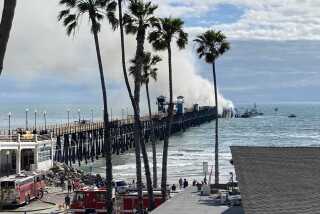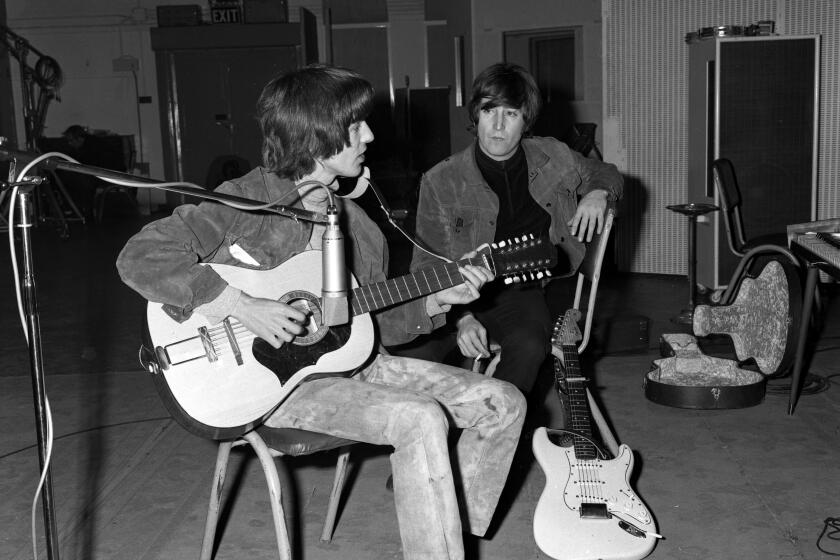L.A’s 49th Street Massacre may not have been about race
On a summer afternoon nearly four years ago, two men carrying AK-47 assault rifles climbed out of a dark red sedan on a quiet South Los Angeles street and opened fire. One gunman shot a 10-year-old boy riding a bicycle, then stood over the child and continued firing at point-blank range. Three people, including the boy, were killed.
The assailants were described as black, the victims were Latino. Police said that the dead were not connected to gangs but that they suspected the attackers were.
What became known as the 49th Street Massacre was one of several high-profile interracial gang crimes that stoked fears among some minority activists of a possible race war.
But as the murder trial of two alleged gang members accused in the killings draws to a close, little evidence has pointed to race as a principal motive in the shooting.
Prosecutors contend that Ryan T. Moore, 36, and Charles Ray Smith, 41, mistook the victims for rival gang members in a tit-for-tat feud over turf, drugs and pride. Defense attorneys do not dispute the prosecution’s theory but say authorities identified the wrong men as the killers.
Although examples of interracial gang killings have heightened racial tension in recent years, the case helps illustrate how complex a role race plays in L.A.’s gang violence. Experts say most conflicts involve gangs of the same ethnicity. But whether hostilities cross racial lines or not, innocent people are frequently caught in the violence.
The 49th Street shooting followed deadly race riots in Los Angeles County’s jails and brawls on local high school campuses between black and Latino students. As tensions simmered, many people feared an escalation in ethnic violence, recalled Earl Ofari Hutchinson, president of the Los Angeles Urban Policy Roundtable.
“It’s still a concern,” Hutchinson said. “There’s a special layer of fear because people are concerned that they’re being targeted … solely because of their race.”
Authorities say the origins of the 49th Street shooting go back to a 2005 dispute over drug territory between the Rollin’ 30s Blood Stone Pirus, an African American gang, and the Eastside Treces, a Latino gang.
“The Eastside Treces were pulling guns out on some of the Rollin’ 30s or anyone black,” Alicia Merceron, who admitted driving the car used in the 49th Street shooting, testified last month.
But Merceron gave no hint that racial hostility was a factor in any violence perpetrated by the Rollin’ 30s members she knew. At least three of the gang’s members were Latino.
Dressed in a pink-and-white blouse, Merceron told jurors in a downtown courtroom that she had an affair with Smith — a reputed Rollin’ 30s shot-caller — and drove him in several drive-by shootings in addition to the one on 49th Street.
The first occurred on March 31, 2006, after a Latino gunman fired shots at a Rollin’ 30s member who was related to Smith’s wife. Merceron said she drove Smith to Martin Luther King Jr. Boulevard, where Smith jumped out and fired an AK-47 into a parked car, killing the driver, Bani Hinojosa.
Merceron said Smith insisted the victim was a gang member. But prosecutors called Hinojosa a construction worker with no gang ties who had been taking milk home to his wife and two daughters when he was shot. Smith is charged with murder in the killing.
A short truce between the gangs was shattered in June 2006 with the fatal shooting of a Rollin’ 30s member, a close friend of Smith’s. Smith vowed revenge, Merceron said.
“He wanted the Eastside Trece to pay for it,” she told jurors.
Two days after his friend’s funeral, Smith told Merceron he had heard that Eastside Trece members were living on 49th Street near Central Avenue, she testified. As they drove along the street, she said, Smith believed he recognized a green SUV as belonging to the rival gang.
Merceron testified that they picked up Moore and returned to 49th Street. She said she did not realize what the men were planning until she saw Moore hand Smith a rifle in her car.
When they arrived at the 1100 block, she said, she locked eyes with a small boy near the parked SUV. Merceron said she scanned the area to see who was watching as the men got out and began shooting.
David Marcial, 10, was killed in the attack. His 12-year-old brother, Sergio Jr., was seriously wounded. Also killed were the boys’ uncle, Larry Marcial, 22, and Luis Cervantes, 17, a neighbor of the Marcial family.
A day after the killings, Merceron had her red Chrysler Cirrus painted silver.
In court, Deputy Dist. Atty. Todd Hicks asked her why she had helped Smith carry out the crimes.
“Because I loved him,” she replied. “He showed me a lot of love.”
Last year, another jury deadlocked 7-5 in favor of convicting Moore and 9-3 in favor of convicting Smith in the 49th Street killings. Several jurors told prosecutors they had doubts about Merceron’s veracity.
Defense attorneys have portrayed Merceron as a manipulative killer with a strong motive to lie.
Although Smith and Moore face possible death sentences, Merceron will get far less under a deal with prosecutors. In exchange for her testimony, she was allowed to plead guilty to manslaughter and is expected to be sentenced to seven years in prison. The agreement depends on her telling the truth. But defense attorneys note that Merceron has told conflicting stories.
In a March 2008 interview with police, she promised to come clean and admitted involvement in the 49th Street killings. She denied involvement in any other shootings.
In a subsequent interview with police, however, she admitted being the driver in three more drive-by shootings, including the Hinojosa murder.
Even then, she was holding out.
During the first trial, Merceron initially denied — then admitted — firing a handgun in yet another drive-by shooting. No one was hurt, she said.
Defense attorneys also cast doubt on her timeline of events just before the 49th Street shooting. They have seized on security footage taken from a local business that prosecutors say shows Merceron’s car turning down 49th Street and then making the same turn 10 minutes later, moments before the shooting. Defense lawyers contend that Merceron’s account — of driving past the SUV, then collecting Moore and the weapons before returning — could not have taken place within 10 minutes.
“This is a character who wakes every morning and has a fistfight with the truth,” Moore’s attorney, Richard LaPan, told jurors.
Nevertheless, both sides agree that race played little role in the slayings. Alex Alonso, a defense gang expert, testified that the Rollin’ 30s continued to peacefully share territory with half a dozen other Latino gangs despite its conflict with the Treces.
“These gangs,” he said, “have existed there for years without any animosity.”
The case is expected to go to the jury next week.
More to Read
Start your day right
Sign up for Essential California for news, features and recommendations from the L.A. Times and beyond in your inbox six days a week.
You may occasionally receive promotional content from the Los Angeles Times.







